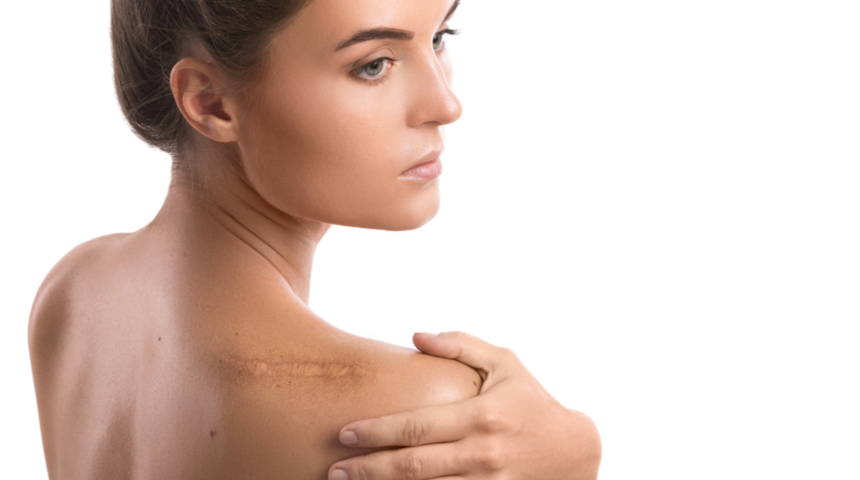Scars occur from injury or physical trauma. It is a natural part of the body’s healing process. After a wound forms on the skin, the body forms collagen fibers (the naturally occurring protein in the body) to repair the skin. Scars form after the wound has completely healed.
For some people, their scars are a painful reminder of the hardships they have gone through in their life. While some people embrace their scars, some still get self-conscious about them. Aside from the psychological and emotional impact that scars have, they also can limit a person physically. It can be itchy, uncomfortable, and restrict movement.
Scars should not be a big problem. For those considering to treat their scars, there are many options for scar treatment out there. However, it is crucial first to identify the type of scar the person has.
Types of scars
There are different types of scars, depending on how the wound heals. Most scars are flat and pale. However, the overproduction of collagen may result in scars that are raised from the skin. Both flat and raised scars are common to children and people with darker skin.
While some scars are raised, scars also may look sunken or pitted. It happens when structures underneath the skin, like fat or muscle, are lost. It is common for surgical or acne scars.
When the skin is stretched rapidly, like during pregnancy, it can also cause the formation of scars. It also occurs in parts of the skin that undergo a certain amount of tension. For example, a wound near the joint may turn into a scar when completely healed.
In general, scars’ appearance depends on the depth and size of the wound and its location. Factors like age, sex, and ethnicity may also play a role in the formation of scars. Different types of scars include:
Keloid Scars
Keloid scars form due to the overproduction of collagen during the healing process of wounds. It happens when a scar keeps growing even after the wound has healed. This type of scar is raised above the skin. It is red or purple when newly formed, but it becomes paler later on. It is often itchy or painful, and sometimes it can restrict movement.
Contracture Scars
Contracture scars are those that are caused by burns. This scar tightens the skin and makes it hard to move. It also can go deeper than the skin and affect the muscles and nerves.
Hypertrophic Scars
Just like keloid scars, hypertrophic scars are formed due to the overproduction of collagen during the healing of the wound. However, unlike keloid scars, this type of scar does not extend beyond the boundary of the original injury. It continues to thicken for up to six months. In the beginning, it is red and raised, but it will flatten and become paler over time.
Pitted or Sunken Scars
Pitted or sunken scars are results of skin conditions, such as acne or chickenpox. It may also occur because of an injury that causes a loss of underlying fat or muscle on the skin.
Normal Fine-line Scars
Fine-line scars are commonly formed from wounds after surgery. This type of scar is not usually painful but may cause itching for a few months. For darker skin types, it might be more noticeable because it leaves a brown or white mark after healing. For people with paler skin, the scar is more evident on tan skin; the scar tissue does not get tan.
How to treat scars?
Complete scar removal is not possible. However, most scars do fade and become paler over time. Still, some people decide to treat their scars to improve the scar’s appearance and make it less noticeable. Scars are also treated because they are uncomfortable or restrictive. There are many types of treatments for scars.
One treatment for scars is prescription creams, ointments, or gels. It is a common remedy for scars caused by cuts or minor injuries. Treatments often include steroids or certain antihistamines, especially to treat scars that are sensitive and cause itching. Silicone sheets or pressure dressings are recommended as preventive care when the wound is healing. It is essential to consult with a doctor for a prescription treatment.
Surgery can also be an option for treating scars. It is commonly done for deeper scars, such as burns. The type of surgery depends on the case of the patient. Surgical options include skin grafts, excision, dermabrasion, or laser surgery. For scars obtained from surgery, it is best to wait at least a year before deciding to treat the scars, to prevent the scars from getting worse.
Another option is through injections. Steroid injections, specifically corticosteroid injections, can treat scars that are raised from the skins, like keloids and hypertrophic scars. It is injected into the scar to reduce swelling and flatten it. An injection may need to be repeated depending on the type of scar.
Another treatment for scars that is growing in popularity is skin micropigmentation as known as scar camouflage.
What is skin micropigmentation?
Micropigmentation, also called “permanent makeup,” or “cosmetic tattooing,” is a cosmetic procedure, where it introduces pigments into the skin. Pigments are individually mixed to match the patient’s skin tone. Then, a micropigmentation artist uses an instrument, which is either manual or electrically driven, to introduce the pigment into the area of skin that needs recoloring.
People who experience breast reconstruction surgeries, or who wants to have hair simulation usually undergo Paramedical Micropigmentation. People who want to have scar concealment also go with this procedure.
Paramedical Micropigmentation is a simple procedure and does not take that much time; one session might take just around one hour. It is relatively cheaper than other cosmetic procedures too. It is also a good alternative for people who have to make up allergies. The results of the method look more natural compared to other cosmetic procedures.
There are many types of micropigmentation treatments for different cases. There is nipple & areola micropigmentation for breast cancer survivors who undergo breast reconstruction surgery. Scalp micropigmentation for people experiencing balding or have a receding hairline. Skin micropigmentation treats skin conditions like vitiligo. For scar treatment, scar camouflage is a good option.
How does scar camouflage work?
Scar camouflage uses pigments that match the skin to make the scar color blend with the surrounding skin. The results of scar camouflage can mimic the look of traditional makeup, which is a good thing when it comes to covering scars.
In this procedure, pigments are introduced to the upper dermal layer of the skin, through a single-use fine needle. Before introducing the pigment, the micropigmentation artist applies a numbing cream to the affected part of the skin. Pigments are then individually mixed to match the patient’s skin tone. Then, the micropigmentation artist uses an instrument, which is either manual or electrically driven, to introduce the pigment into the area of skin that needs to be concealed.
The result of the treatment may vary depending on the condition and severity of the scar. Scar camouflage is not a one-time procedure, and it may take two or more sessions to achieve the desired color. It is also important to remember that scar camouflage can only conceal the scar, not remove it.
When is scar camouflage done?
Scar camouflage may not be the best option for every type or condition of scars. This treatment is a suitable option for the following:
- Burn Scars
- Acne Scars
- Hypo Pigmentations (patches of skin that are lighter than the surrounding skin)
- Plastic Surgery Scars
- General Surgery Scars
- Stretch Marks
- Scars from Cleft Palate Repair
- Injury Scars
- Congenital Anomalies
- Vitiligo
- Port Wine Birthmarks (only after multiple sessions with a laser to cauterize the vessels and only under recommendation and doctor’s order)
Scar camouflage is not recommended for the following conditions:
- If the scar is still pink or changing color. The scar should be at least one year old.
- If the scar is not smooth or flat enough, if the area is bumpy or raised, the treatment will not be effective.
- If the scar has dark edges. The dark edges indicate Post Inflammatory Hyper-pigmentation (PIHP) from physical trauma or surgery. Scar camouflage may worsen the condition. It affects mainly people with dark skin tones.
- If the person has keloids.
- It is not advisable for spider veins; freckles; age spots; under eye circles; hyper-pigmentation.
Scar camouflage preparation
Scar camouflage is not a major medical surgery, but it still needs to be prepared for. Make sure that the skin is prepped. Eliminate any dead or dry skin in the face or body by exfoliating using a scrub and exfoliating wash. For sensitive skin, a cotton washcloth can be used. Also, moisturize the surface, but do not use makeup over the skin that is oily or greasy.
Moisturising and exfoliating are necessary to have a soft, smooth skin that the pigment can adhere to, which can lead to longer-lasting and results and even finish.
Scar camouflage aftercare
After the procedure, take note that the color of the skin will be darker than expected. The color of the pigment will fade over time. The skin might also look red directly after; it will subside after 1-4 days.
The process of scar camouflage does not end with the procedure. To achieve the desired result, aftercare is vital. Make sure to avoid the following things:
- Avoid astringent soaps or cleansers in the pigmented area.
- Avoid heavy moisturizers, creams, and makeup in the area.
- Avoid picking or scratching scabs that form in the area. Scabs are normal, and it will naturally fall off over time.
- Avoid long baths or hot showers.
- Avoid places like pools, saunas, jacuzzis.
- Avoid direct sunlight to the area and going to tanning beds or spas.
- Avoid exercising or activities that cause heavy sweating for 24 hours.
- Avoid products containing Aloe.
If the treatment was done in the face or head, having the head slightly raised while sleeping may prevent swelling. Also, make sure to apply healing balm in the area three times a day and make sure that hands are always clean. Lastly, make sure to apply petroleum gel in the area before showering or avoid showers for 14 days.
Things to consider
Scar camouflage is an invasive procedure, which means that it uses a needle to penetrate the pigment into the skin surface. It may come with some risk:
- Infection
- Allergic reactions
- Inflammation
- Keloid formation or further scarring
- Pigment spreading to other parts of the skin
- MRI complications
Factors that affect the result
Scar camouflage does not automatically provide excellent results. There are many factors that may affect the final outcome of the treatment:
- Natural skin tones
- Body’s healing ability
- Medication
- Skin characteristics (dryness, oiliness, sun damage, thickness, color)
- pH balance of the skin (acidity)
- Alcohol intake
- Smoking
- Illness
Scar camouflage Singapore
Many people in Singapore have the opportunity to scar camouflage to solve their scar problems. It is not that hard. There are many cosmetic studios in Singapore, offering the procedure. They work with state-of-the-art equipment and highly trained artists and technicians to ensure quality service for their clients. Another critical thing to look for is the right pigments. One popular pigment brand in Singapore is Swiss Color.
Swiss Color is a global company that offers an array of pigments. The company invested in years of research and development to come up with their pigments that are safe and free of heavy metals. Swiss color introduces a wide array of pigments, in different shades, for various micropigmentation procedures, including scar camouflage, to achieve the desired result. Swiss Color is available in 54 countries, including Malaysia, Indonesia, Thailand, and Singapore.





